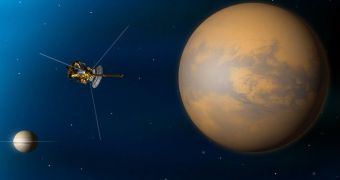Today, September 24, the NASA Cassini spacecraft will perform a new flyby maneuver around Titan, the largest moon orbiting the gas giant Saturn. This will by a high-altitude swing-by.
Experts at the American space agency say that the orbiter will have a busy schedule in the following year and a half, especially when it comes to investigating Titan.
The moon has been determined to be one of the most interesting places in the solar system, and has been Cassini's target since the explorations robot arrived at Saturn, on July 1, 2004.
In the following years, the probe did a large number of flybys around the celestial body, revealing season and wind patterns, temperature levels, as well as the existence of lakes made entirely out of liquid hydrocarbons, such as methane and ethane.
Using its onboard instruments, Cassini also managed to map the polar regions of the moon, producing the most accurate representations of how Titan looks like we ever had.
Over the coming 18 months, the orbiter will be in such a configuration that it will only be able to execute high-altitude flybys of its target.
For example, the new flight will take the spacecraft some 8,175 kilometers (5,080 miles) above Titan's surface, say experts at the NASA Jet Propulsion Laboratory (JPL), in Pasadena, California.
The team here manages the Cassini mission for the Science Mission Directorate, at the NASA Headquarters, in Washington DC.
One of the main targets for research will be determining the influences that the spring season has on the Saturnine moon. The latest equinox occurred in August 2009, and now Titan is experiencing spring.
For a long time, researchers have said that the distribution patterns of hydrocarbon lakes may vary seasonally. Now is their chance to prove scientifically that this actually happens.
“Cassini's composite infrared spectrometer instrument will be probing Titan's stratosphere to learn more about its vertical structure as the seasons change,” JPL experts say in a press release.
“[...] visual and infrared mapping spectrometer, will be mapping an equatorial region known as Belet at a resolution of 5 kilometers (3 miles) per pixel,” the researchers add
“This mosaic will complement the mosaics that were obtained in earlier Titan flybys in January and April. This spectrometer will also look for clouds at northern mid-latitudes and near the poles,” they conclude.

 14 DAY TRIAL //
14 DAY TRIAL //